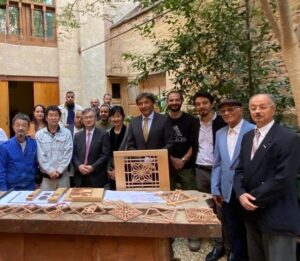When visiting a monument in Historic Cairo, you learn its history from the people working there. The matter in Beit Yakan is totally different. There you can meet the present owner, Alaa El-Habashi, to learn the history of the previous inhabitants and the continued restoration of the house.
El-Habashi, who is a professor of architecture and heritage conservation, told the Egyptian Mail that he bought the house in 2009.
“The original owner was Hasan Agha Koklian of the Ottoman army. Like the local residents, he made weapons for the Egyptian army,” el-Habashi said.
“Koklian built this neo-Mamluk-design house in 1640 annexing to it a sabil (water dispenser) and a kuttab (Quran school for children).”
In 2001, el-Habashi obtained his doctorate from Pennsylvania State University in restoration and preservation of urban and architectural heritage and historic Cairo was his go-to place to apply his studies.
“I delved deep into alleys where I learnt a lot about its people and heritage. I found that the courtyards of the houses were heritage locations that had a social and economic role,” he said.
The house with its courtyard was at the core of the alley. “Every alley in Egypt has its core house where a master craftsman or a prominent person lived,” he added.
Beit Yakan is named after a nephew of Egypt’s de facto ruler, Mohamed Ali Pasha (1805-1848), who sent him on a campaign against the Wahhabis (1811-1818) in what is now Saudi Arabia. When he returned, Mohamed Ali granted him this house.
The house is located in Souq el-Selah (Market of Weapons), where Mohamed Ali had transferred arms making to the Citadel, where he governed, and made people of the street leave their shops and houses.
Then, he let his relatives and friends live in the areas surrounding the Citadel such as Souk el-Selah street to be near to him. Mohamed Ali granted the biggest of these houses to Yakan.
After Yakan left the house, a woman with no children lived in it. Before her death she left it to her maidservant. El-Habashi bought the house from one of her grandsons, who used the courtyard as a slaughterhouse.
“In 2005, part of the house was literally demolished after the 1992 earthquake aftershocks. The original occupants had abandoned the house and lived in the courtyard.”
El-Habashi, who stays most of his time in the house, noticed during restorations two designs; the first is in Mohamed Ali’s style, which is the European Baroque, the second which was hidden behind is Mamluk. This appears clearly in walls, floors, and decorations.
“When Mohamed Ali granted the house to Yakan, the latter covered up every Mamluk detail. How could he live in a Mamluk-designed house and his grandfather killed them in the Citadel massacre,” said el-Habashi, who is also head of the Department of Architecture in Menoufia University.
“But when I restored it, I preferred to show part of these hidden Mamluk elements.”
El-Habashi said that the house had no electricity nor sanitation. Among the main restoration processes he made is to put a solar unit, making it the first ever Islamic monument in Historic Cairo to have one.
The house consists of a ground floor with its courtyard, which is associated completely with society.
He said that during the Mamluk and Ottoman eras, the courtyard witnessed trade, and activities related to the community, as well as serving as a club for children.
El-Habashi said that the current Beit Yakan is not a cultural centre, it is a community house that has a developmental role related to denizens of the area.
“The area here is rich in carpenters, especially those working in traditional carpentry such as those who make mashrabiyas and decorations on doors. So I think we can revive the economy of the area by co-operating with the Japanese Embassy in Cairo,” he said.

There is a place in the courtyard allocated to hold the ‘Traditional Craft Revitalisation and Training Centre in Old Cairo’, which opened last December. This project was implemented by the Nile Palace Charity Foundation, using a Japanese grassroot grant of $85,749.
“The carpenters come and train people here. They were taught how to upgrade their design by exchanging experience with the visiting Japanese traditional carpenters,” el-Habashi said.
Japanese Ambassador Oka Hiroshi said during the opening ceremony he was glad that Japan played an important role in preserving the historic area and revitalising the community through the grassroots grant.
In Beit Yakan, two Japanese carpenters; Morita and Yasuda from Kanazawa city shared their knowledge and experience as well as exchanged traditional skills and culture with young carpenters in the local community in ‘kumiko’, the Japanese technique of assembling pieces of wood without nails.
El-Habashi said that through the grant, they bought woodworking machines for the carpenters through which they can revive Egyptian heritage.
“Heritage is not just houses, heritage is communication with the coming generations.”




